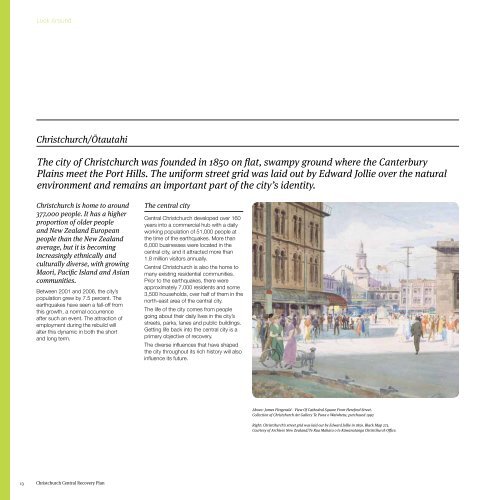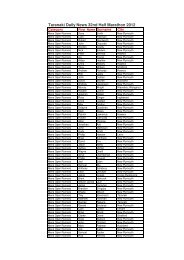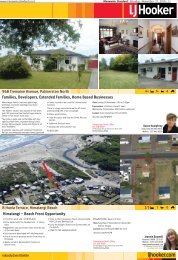Christchurch Central Recovery Plan - New Zealand Listener
Christchurch Central Recovery Plan - New Zealand Listener
Christchurch Central Recovery Plan - New Zealand Listener
- No tags were found...
You also want an ePaper? Increase the reach of your titles
YUMPU automatically turns print PDFs into web optimized ePapers that Google loves.
Look Around<strong>Christchurch</strong>/ŌtautahiThe city of <strong>Christchurch</strong> was founded in 1850 on flat, swampy ground where the CanterburyPlains meet the Port Hills. The uniform street grid was laid out by Edward Jollie over the naturalenvironment and remains an important part of the city’s identity.<strong>Christchurch</strong> is home to around377,000 people. It has a higherproportion of older peopleand <strong>New</strong> <strong>Zealand</strong> Europeanpeople than the <strong>New</strong> <strong>Zealand</strong>average, but it is becomingincreasingly ethnically andculturally diverse, with growingMaori, Pacific Island and Asiancommunities.Between 2001 and 2006, the city’spopulation grew by 7.5 percent. Theearthquakes have seen a fall-off fromthis growth, a normal occurrenceafter such an event. The attraction ofemployment during the rebuild willalter this dynamic in both the shortand long term.The central city<strong>Central</strong> <strong>Christchurch</strong> developed over 160years into a commercial hub with a dailyworking population of 51,000 people atthe time of the earthquakes. More than6,000 businesses were located in thecentral city, and it attracted more than1.8 million visitors annually.<strong>Central</strong> <strong>Christchurch</strong> is also the home tomany existing residential communities.Prior to the earthquakes, there wereapproximately 7,000 residents and some3,500 households, over half of them in thenorth-east area of the central city.The life of the city comes from peoplegoing about their daily lives in the city’sstreets, parks, lanes and public buildings.Getting life back into the central city is aprimary objective of recovery.The diverse influences that have shapedthe city throughout its rich history will alsoinfluence its future.Above: James Fitzgerald - View Of Cathedral Square From Hereford Street.Collection of <strong>Christchurch</strong> Art Gallery Te Puna o Waiwhetu; purchased 1997.Right: <strong>Christchurch</strong>’s street grid was laid out by Edward Jollie in 1850. Black Map 273.Courtesy of Archives <strong>New</strong> <strong>Zealand</strong>/Te Rua Mahara o te Kāwanatanga <strong>Christchurch</strong> Office.13<strong>Christchurch</strong> <strong>Central</strong> <strong>Recovery</strong> <strong>Plan</strong>















